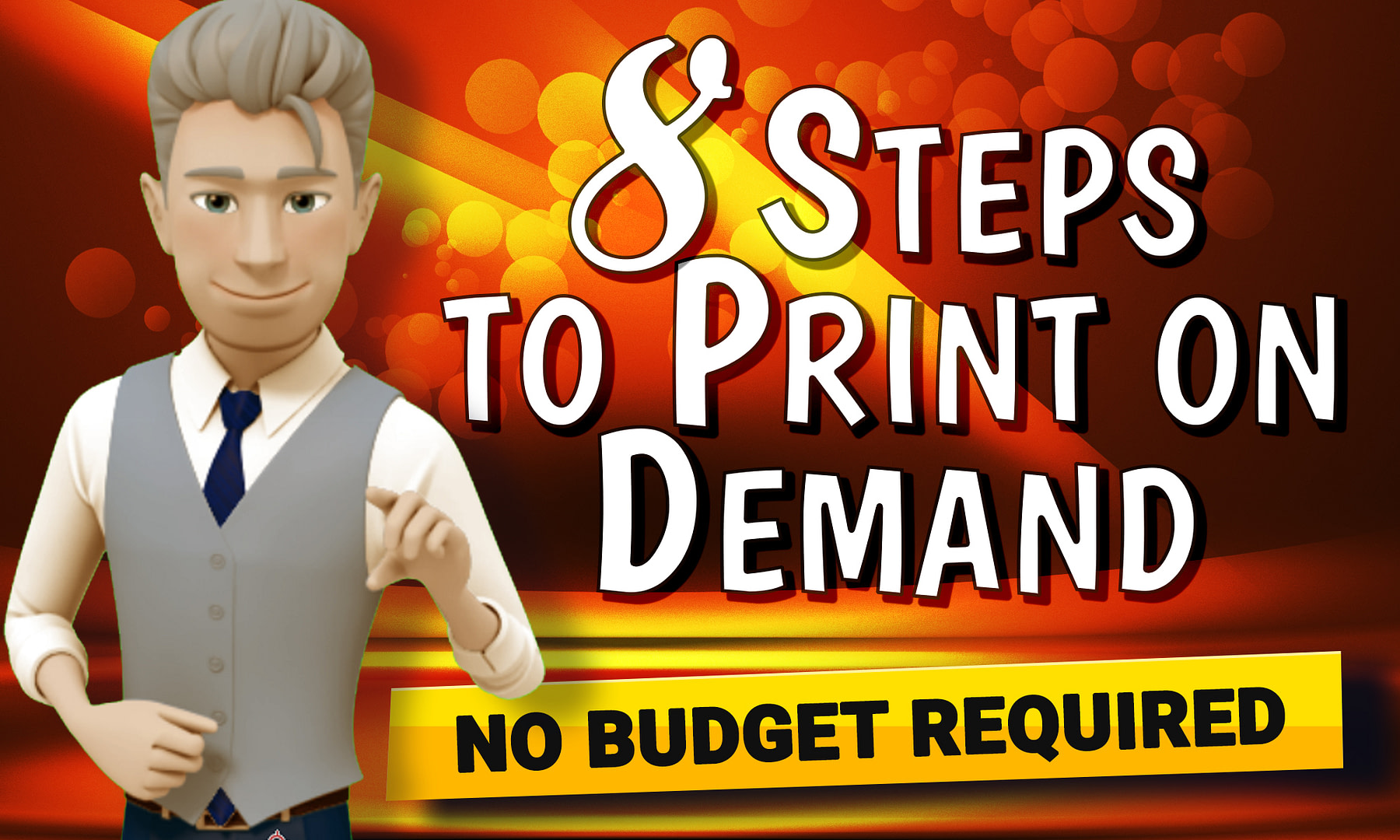Watch this article on video
★ PRINTFUL registration and product creation TOTALLY FREE
How to start a print-on-demand business in 8 steps
Print on demand businesses have become increasingly popular in recent years. This is because there are few business models that allow you to start with almost no initial budget, while allowing you to create a profitable business with huge passive income potential.
You will be able to sell physical products, without having to acquire inventory, which is one of the most fascinating benefits of a print-on-demand business. This is because the print-on-demand provider manufactures your items, based on your designs, and handles order fulfillment, packaging, shipping and customer service.
This means you can start a simple part-time print-on-demand business or turn it into a very successful business, earning tens of thousands of dollars a month or more.
Stop thinking about creating products, shipping items, or all those time-consuming tasks. Whether you’re a designer, an artist, or even someone who has no talent for design, as long as you have the drive to make a living from your creativity, you can start your own print-on-demand business right now.
Why start a print-on-demand business?
There are many reasons why a print-on-demand company may be of interest to you.
- No need for inventory.
To sell physical items, you usually have to buy a stock of the products you want to resell. This requires you to have an adequate budget before you start. Financing this inventory often creates cash flow issues as you look to grow your business, add new products and expand your item lines. These issues do not arise with the print-on-demand business model.
Low start-up costs.
It’s possible to start a print-on-demand business on a very small budget. You can market your items on an existing marketplace, such as Etsy, Ebay, Amazon for example, without investing any money at startup, or create your own website for a budget of less than $100. The business opportunities you can create with such a small amount of money are very rare. - Flexible hours.
You can work in print-on-demand whenever you want, because you have complete control over your business. You can fit your print-on-demand business around your current schedule. This flexibility is a great asset if you already have a boring, low-paying job or if you want to create your own job with complete freedom. - Work part-time or full-time.
Print-on-demand businesses can be run on a part-time or full-time basis, depending on your goals. This method of selling is ideal if you are looking for a side business to supplement your income. If you’re looking to break free from a full-time job for another boss, you can grow your business until it provides the income you need. - Work wherever you want.
Since you can run your print-on-demand business from anywhere in the world, it’s an ideal solution if you want to be completely independent, free to travel. You can run your business while traveling or living in another country. - Work can be outsourced.
Print-on-demand usually involves some level of design or creativity to create the products you will offer for sale. However, you do not have to do the graphic design work yourself. You can hire a graphic designer, on sites like Fiverr or Upwork, to create t-shirts or other print on demand products. - High scalability.
It’s easy to grow a print-on-demand business. As your sales grow, you can easily add designs and offer more products. There’s no need to invest in a larger inventory or production facility.
All you have to do is design or select your designs, have them printed, sell them and earn passive income on an ongoing basis. Are you interested in this concept? If so, we invite you to dive into this 8-step process to understand how to start a print on demand business today.
Step 1: Decide how you want to sell your design
When starting a print-on-demand business, one of the main choices you need to make is selecting the right platform to launch your business. You have two basic options: sell on an existing marketplace or create your own online store. If you’re not sure where to start, here are the pros and cons of each option.
The first option: Sell on the marketplace of your choice.
The easiest and fastest way to get started is to sell your designs on sites like Etsy, Amazon, Ebay, Facebook, Walmart, etc. With this approach, all you have to do is create an account, upload your designs and start selling.
The downside of selling on an existing marketplace is that you will be competing with other designers. You will be one of the many artists, offering their creations on this platform. The competition is very strong, and your potential customers may pass by your store, then go to buy from another competitor.
In return for the notoriety and the existing traffic, that it offers you instantly, the marketplace takes a part of each sale, which reduces your profit margin.
The second option: create your store on your own website.
You can create your store on Shopify, WooCommerce, BigCommerce, ShopBase, etc. Then upload your designs to your store. Connect your store to the print-on-demand platform of your choice. When a customer places an order on your website, your chosen print-on-demand platform will print the design and deliver the product to your customers.
By creating your own store, you have more control over your business. This solution will allow you to sell any type of product you want, and will also allow you to create your own brand. You have total control over your store, and you can customize it as you wish.
By creating your own online store, you won’t have to share your revenue with a marketplace that hosts your store.
How do you know what is the best way to sell your designs? In general, it depends on your business strategy and budget.
A platform has an established reputation, a large audience and a lot of traffic that you can use. The implementation is very fast. Because of the low cost of opening a store on an existing platform, this method has less financial risk. On the other hand, you have little control over your online store, and you will have to deal with many competitors.
On the other hand, if you have a large budget, creating your own print-on-demand store may be right for you. You have full control over your website. You can easily collect data about your customers and, most importantly, you have no competitors on your online store. On the other hand, creating and maintaining your online business requires more effort.
Step 2: Find a niche
The first thing to do when starting a print on demand business is to choose a niche. But you still need to know what a niche is. A niche refers to a very specific market segment. The main goal is to find a group of people who share the same interest in something. Instead of trying to sell your items to everyone, a niche strategy will allow you to cater to a group of people who are more likely to buy your products. This will not only help you stand out from the crowd, but also increase your sales.
To find a niche for your print-on-demand business, start by thinking about a list of potential markets or groups of people you could target. For example, your niche could be moms, pet lovers, travelers, video game fans, fishermen, fitness enthusiasts, people who like humor, etc. Once you’ve selected several niches, do some research to determine which one sells best. You can also combine different niches to expand your customer base and sales potential.
Step 3: Find your print-on-demand products
Now that you have chosen a niche, it is time to decide what products you will sell. There are many options available to you. The key is to choose products that will be popular with your target audience. To help you choose the right products, look at the different trends in your niche. What are people talking about? What do they seem to be interested in? You can also look at what other companies in your industry are selling. This can give you some ideas about the types of products you might want to sell.
There are an infinite number of products to sell, and you may feel overwhelmed by the choice at this point. You probably know about t-shirts, sweatshirts, hats, bags, clutches, coffee mugs, notebooks, agendas, phone cases, mouse pads, stickers, pillows, etc.
To find your print-on-demand products, you can use many tools like Google Trends, or Google Search. Google Trends is a great way to see what people are searching for and how trends develop or disappear over time. You can also use Amazon, eBay, Etsy, and other major marketplaces to discover what products are selling in your niche.
Step 4: Prepare your design
It’s time to create your designs. Of course, you need to keep your target audience, your niche, in mind when creating your designs. Your products must absolutely appeal to the customer segment you want to sell your designs to. During this step, avoid plagiarism above all. You should try not to steal or violate copyrights with the words or designs printed on your products.
Even though a print-on-demand company is looking for a unique design, you don’t need to be an experienced designer to create designs that sell. There are two options for creating your designs.
The first option is to hire a graphic designer. Hiring a professional graphic designer may seem expensive, but you may be pleasantly surprised by what you can achieve, even on a limited budget. With sites like Upwork and Fiverr , you can hire experienced graphic designers without breaking the bank. You can even find graphic designers who specialize in creating designs for your print-on-demand products.
The second option is to use print design templates. This is a great way to get started if your budget is limited. However, you’ll need to pay attention to licensing details. Many licenses come with restrictions that you should be aware of. For example, you may have to significantly modify a resource or template before you can use it for a print-on-demand product. The Creative Fabrica and Vexels websites are two excellent marketplaces for finding templates that you can use in print-on-demand products. Using templates can be a great way to get started quickly. You can also use Canva , Place-It T-shirt Designer to create quality designs for your products.
Step 5: Choose the right platform and create your products
Now it’s time to choose your supplier. This is the company that will print and ship your products with your designs. Some of the most popular suppliers include Printful, Printify and Gelato. You can easily integrate these vendors with your website or marketplace of choice. This way, when a customer places an order, the details of the order are sent directly to the supplier for fulfillment.
Most suppliers offer a wide range of items and make it easy to get started in the print-on-demand market. All you have to do is upload your template and choose the products you want to sell, which will be printed with your design.
While it is easy to get started, choosing a supplier is a crucial decision that should not be taken lightly. The manufacturer you choose must be serious, and will have a huge impact on the quality of the products your customers will receive, and on the overall perception of your brand. It is therefore advisable to order samples from a few suppliers, so you can check the quality of the products and prints for yourself. You can also read online reviews to know the qualities and shortcomings of print-on-demand suppliers.
You need to do further research to evaluate the performance of the suppliers and determine if they meet your quality requirements. Here are some criteria that will guide your choices. The supplier’s compatibility with your website or platform of choice, product quality, production time, delivery time, product price, production and storage location, refund policy, customer service.
You should pay utmost attention to the product quality and delivery time. Because this can not only influence the satisfaction of your customers, but also the reliability of your brand.
Nevertheless, don’t limit yourself to one supplier. You can sell several products, from different print-on-demand companies.
Step 6: Set your price
First step, estimate the cost of your product.
- To begin, you need to estimate the cost of design, which is the production of the design that will be printed on your item. If you are hiring a designer, divide the amount you pay the designer by the number of units of the product you plan to sell. DESIGN COST PER PRODUCT = DESIGN PRICE / NUMBER OF DESIGNS YOU PLAN TO SELL.
If you design your own designs, it is normal to want to neglect the design costs to keep the selling price down. However, the time spent on your product is still important, so calculate a reasonable hourly rate for your work. Then add your design costs to the price of your item. - The production cost is included in the price you pay for each item to your print-on-demand printer.
- Shipping costs. If your print-on-demand provider handles the shipping of your items, your customers will have to pay additional shipping costs. One solution is to offer free shipping to your customers, rather than charging them extra. If you offer free shipping, customers will be much more likely to buy your product. You can do this by including the fee in the base price of your products, so you don’t have to pay for shipping separately. Buyers can’t help but take advantage of something free, even if it increases the price of their products.
- Taxation. Another issue to consider is taxes. The print-on-demand company may add a tax on your purchases, depending on where your end customer is delivered. You may also have to collect taxes from your customers. These taxes may or may not be included in the price of your items, depending on the circumstances. In the U.S., taxes can range from 4% to 10%, while in the European Union they can range from 17% to 27%. The amount of these taxes can be generated automatically and directly by the platform that hosts your store, or by a plugin that automates its calculation on your website.
- The fees charged by the platforms per order and per product. If you sell online, you will need to use one of the many platforms. Some of these platforms, like Shopify, have a flat fee; others, like Etsy or eBay, take a percentage of your sales in addition to charging you a fee for each product you create.
Second and last step, add your margin.
Once you’ve taken inventory of all the expenses associated with creating, selling and delivering your products, add them up and add your margin to get your selling prices. Then adjust your margin to meet or exceed your competitors’ sales performance. Experiment with different pricing strategies. However, make sure your prices are always within the “acceptable” price range of the market. It can be difficult to make sales if you are selling for much more than your competitors. Also, don’t forget the time and effort you put into your business and don’t set your prices too low.




